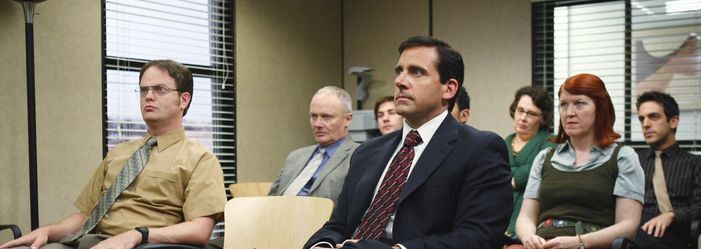Employee Disengagement Is Only Funny in The Office: Real-Life Impacts
Suffering from poor customer service and reduce productivity? You may have a case of employee disengagement.

We can laugh at the dysfunctional antics of The Office employees, but what would a real business look like with Dunder Mifflin employees? Hint: Not productive.
The Office employees were rather disengaged. They spent much of their time hanging out, chatting, playing pranks, and sitting in very unproductive meetings.
Did you ever wonder how their company survived? Here’s what would have happened to a real business with disengaged employees.
How Does Employee Disengagement Impact Your Company?
One unmotivated employee may not seem like such a big deal. Frustrating, of course, but probably unlikely to impact your business. Guess again. A disengaged employee can touch nearly every aspect of a company.
Poor Customer Service
Think about any negative customer experience you’ve had. Do you think the employee you interacted with was deeply invested in their job? It isn’t likely they were. Employees rarely treat customers poorly because they love their job so much.
Unhappiness is difficult to hide, even when you know you should. So a disengaged and unhappy employee isn’t the ideal candidate to deal with your customers. You can forget about them going the extra mile in customer service when you can’t even get them to do just the expected amount.
Low employee engagement coincides with companies’ low customer satisfaction scores. Businesses that receive only so-so or worse customer service ratings have only 49% of their employees actively engaged. That’s compared to a 79% engagement rate for businesses with above-average customer satisfaction scores.
The customer experience is crucial to your company’s reputation. A customer’s negative experience can cause you to lose them and their friends. And don’t forget the power of spreading bad reviews on social media.
Reduced Productivity
Disengaged employees are unmotivated employees. And when you have an unmotivated employee, there’s little you can do to get them moving; it needs to be their choice.
Lower productivity rates can be a financial drain on a company. When you look at a business that enjoys high employee engagement rates, they have a rate or production that’s 17% higher than other, less engaged companies.
And it isn’t only that the work isn’t getting done when employees are unmotivated; the work that is done is often sloppy and full of errors. That sets productivity back; it takes time to fix the work that wasn’t done correctly. This means an even greater loss of productivity. That time could be spent moving the company forward, not doing the same job twice.
Inability to Meet Corporate Goals
In any area of life, not just in business, a goal can only be achieved if it has total buy-in from all invested parties. How can a company get where it wants to be if everybody isn’t pulling their weight?
It may not feel fair, but disengaged employees can hold a team, or even maybe the entire organization, back from reaching their projected aims. Every time work doesn’t get done correctly, or at all, that’s another step further away from achieving the desired result.
That isn't a huge deal if these situations happen once or twice. But when work is regularly late, sloppy, or just plain wrong, that’s an entire series of events that move the needle further and further away from the finish line.
Financial Loss for the Company
Disengaged employees aren’t likely to think outside of themselves regarding the rest of their company. Still, they likely justify their lack of engagement to themselves by saying that they aren’t hurting anybody. They possibly feel that they are skating by unnoticed.
But that isn’t true. Employee disengagement affects the company’s bottom line. Actively disengaged employees cost a company 34% of each paycheck. That’s how much work doesn’t get done each pay period, and also factors in the loss of clients.
A small start-up company could break under such financial pressure. There isn’t much room for employees to pull back from their roles.
Of course, it’s also surprisingly expensive to replace that employee if it comes to that. Interviewing and onboarding new hires require a great deal of time and cost a lot. It would be less expensive to reengage and possibly retrain the disengaged employees.
An Outbreak of Disengagement
Spend any amount of time with your family, and you’ll realize pretty quickly that feelings are contagious. When one person is in a foul mood, it rubs off on the rest of the people in the house. When somebody is feeling silly and having fun, the others can’t help but join in!
The same happens in an office. However, disengagement in the office runs deeper than just a passing mood. This is long term and never varies. Think about it this way: Phil is disengaged from his job. His co-workers see that he’s slacking off, and they begin to resent having to clean up after him or carry his weight. Soon, everybody is angry all the time. Or worse, the rest of the employees become disengaged, too, because they figure if Phil can get away with that behavior, why can’t they?
This is one contagion that can be terminal.
Employee Retention
It probably isn’t a surprise to see turnover rates ranking on the list of problems caused by employee disengagement. Why would an employee stay if they feel no connection to the company? More likely, they’ll want to find a job they can feel excited about.
Employee turnover is a drag. It causes a lot of upheaval in the office. First, there’s the search for new candidates, time spent on interviews, and then the effort to onboard the new hires.
This is all time that companies should spend focusing on getting work done, so it also costs money. Employee churn costs US companies $11 billion each year. It’s much cheaper to try to reengage and energize your current employees. Engaged employees are 87% more likely to stick around.
Employee Disengagement Affects Every Area of a Business
When people are unhappy, it’s difficult to see how they may affect others around them. The employee only knows they don’t feel passionate about their work; what they don’t realize is that their actions (or lack of) touch nearly every aspect of the company. It’s sort of like the butterfly effect. Company profits, production levels, and even the office culture can all suffer from disenagement. Employee dissatisfaction and lack of engagement has massive ramifications.












